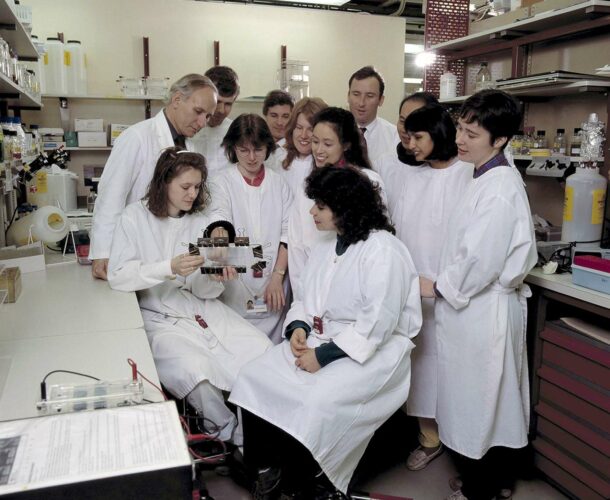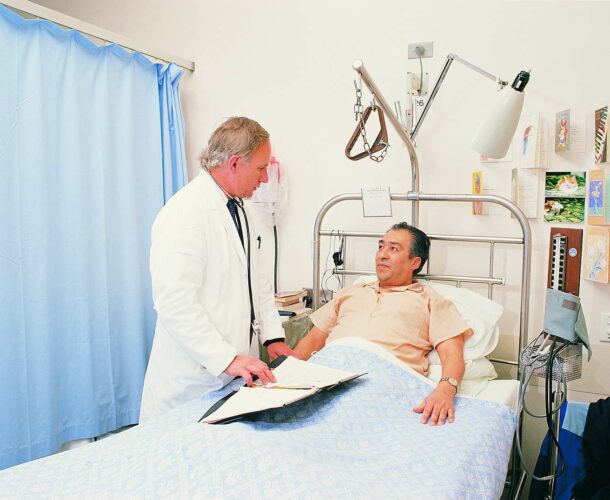In 1987 endocrinologist Professor Len Harrison joined the institute as head of the Burnet Clinical Research Unit.
Harrison’s clinical and research interest was diabetes, particularly type 1 diabetes, and how it might be prevented.
“But we couldn’t prevent diabetes if we didn’t know who would develop it,” Harrison says.
“So the first thing to do was work out how we could predict which people were at risk of developing type 1 diabetes.”
As Nossal explained, Harrison was interested in “whether the autoimmune process can be nipped in the bud by a ‘negative vaccine’, a manipulation which negates the fury of the autoimmune T cells?”1
Autoimmunity and diabetes
Type 1 diabetes is an autoimmune disease.
Immune cells called killer T cells mistake insulin-producing beta cells in the pancreas as ‘foreign’, attacking and killing them. These killer cells should be destroyed in the early stages of our development because they are auto-reactive, but some escape this ‘negative selection’ process.
“We all have potentially self-reactive T cells,” Harrison explains. “However the body does a pretty good job of regulating them so they don’t cause damage.
“In people who develop type 1 diabetes, this regulation is compromised and the body is no longer able to control the killer cells. The silently destroy the insulin-producing cells in the pancreas until the first tell-tale symptoms of diabetes appear. This is usually during childhood or in young adults.”
Predicting diabetes
“Before asking what a negative vaccine might look like, the first question was can we actually diagnose pre-diabetes?
“It was imperative to get a better knowledge of the natural history of the disease. Second, it was important to establish which autoantigens were the target of the autoimmune attack.”1
For the next eight years, Harrison and colleagues including Dr Peter G Colman at The Royal Melbourne Hospital and Dr Margo Honeyman identify autoantigens – the molecules in the beta cells that are targets for destruction by killer T cells. Among their discoveries is that glutamic acid decarboxylase (GAD) is a key target for T cells in people with type 1 diabetes. They also find that genetically at-risk infants followed from birth develop antibodies to insulin, pinpointing insulin as an autoantigen.
In 1997 they show that insulin is the key driver of type 1 diabetes development in a mouse model.
Clinical trials
To gain better insight into pre-diabetes, Harrison, Colman and colleagues from other hospitals mount a major study, running for many years, on about 4000 first-degree relatives (mainly siblings or children) of people with known type 1 diabetes
The study looks for early warning signs of impending diagnosis.
“One in five Australians diagnosed with type 1 diabetes have a family history of the disease, such as a parent or sibling with type 1 diabetes,” Harrison says.
“However having a close family member with the disease does not guarantee you will get it too.”
The studies looked at whether relatives had self-reactive antibodies, including antibodies that recognised islet cell molecules such as insulin and GAD.
“In parallel with researchers in the US and Europe, we found that antibodies to insulin and GAD were able to identify 90 per cent of relatives who would go on to develop diabetes.”
“Those early studies were really the beginning of our almost 30-year quest to prevent type 1 diabetes,” Harrison says.
“Since then, we’ve been able to predict with increasing accuracy those who will develop type 1 diabetes and how long it is likely to take before they are clinically diagnosed.
“This has been essential in our quest to develop a preventive vaccine, both in identifying those most likely to benefit and in measuring whether the vaccine is having an effect to delay or prevent type 1 diabetes.”



